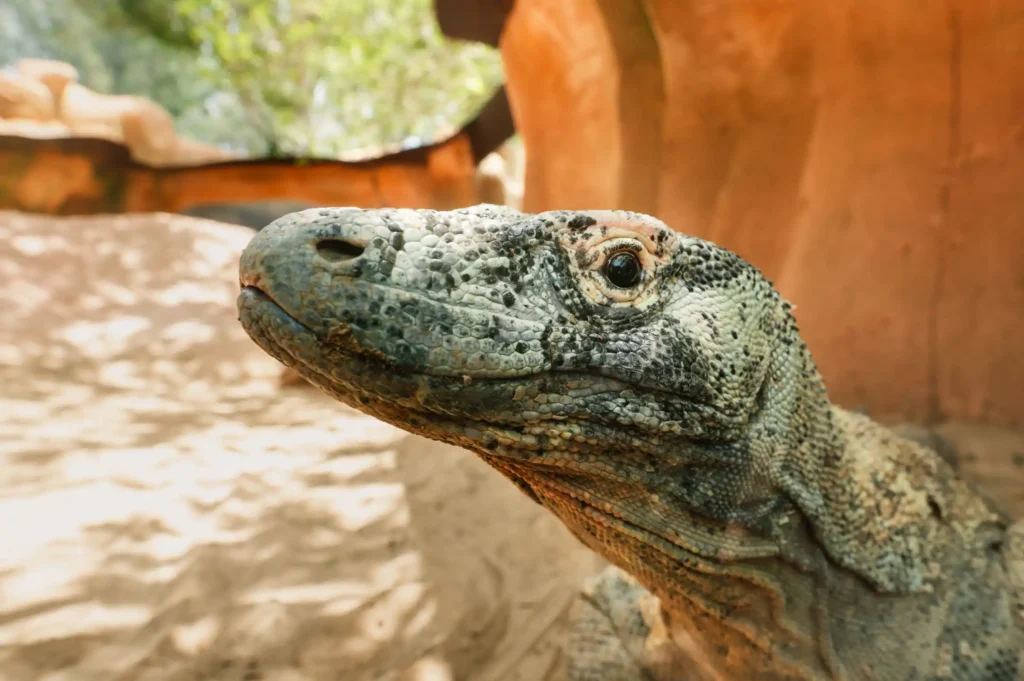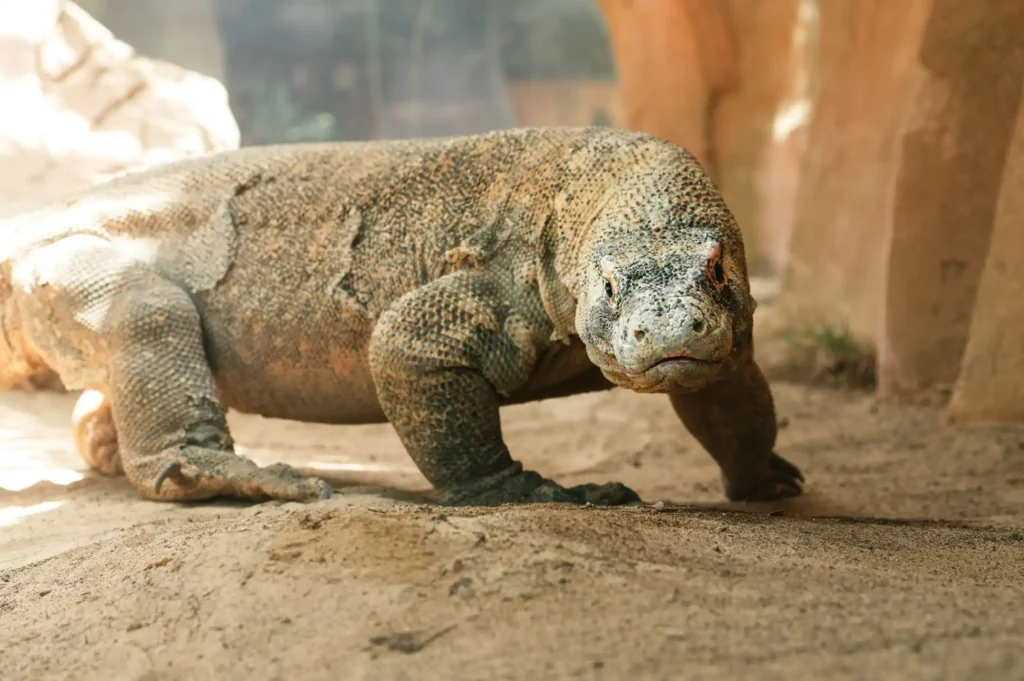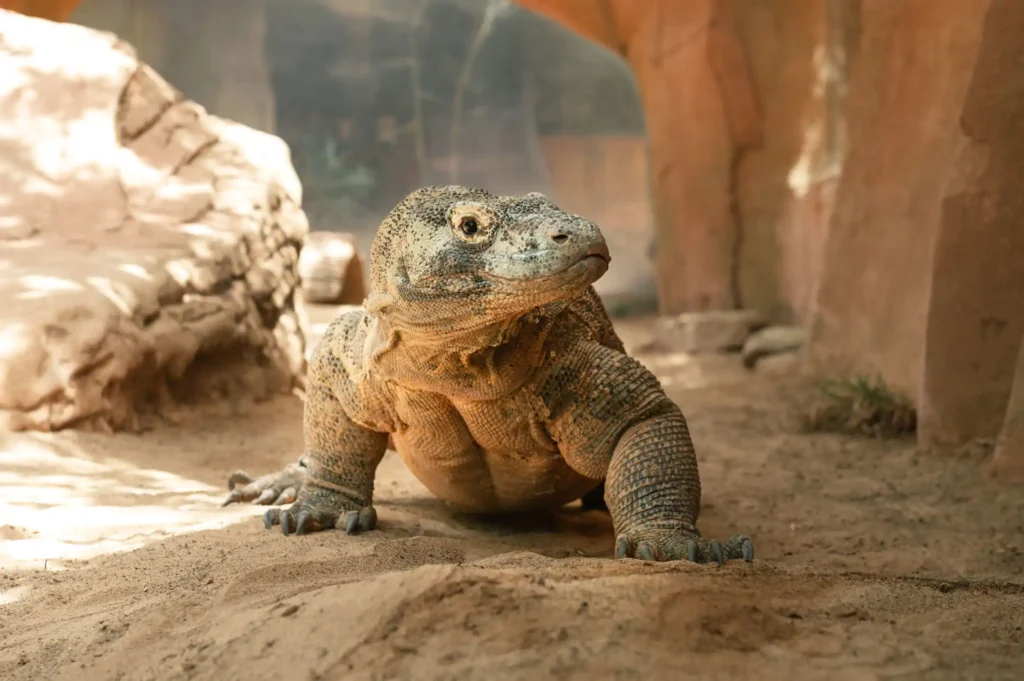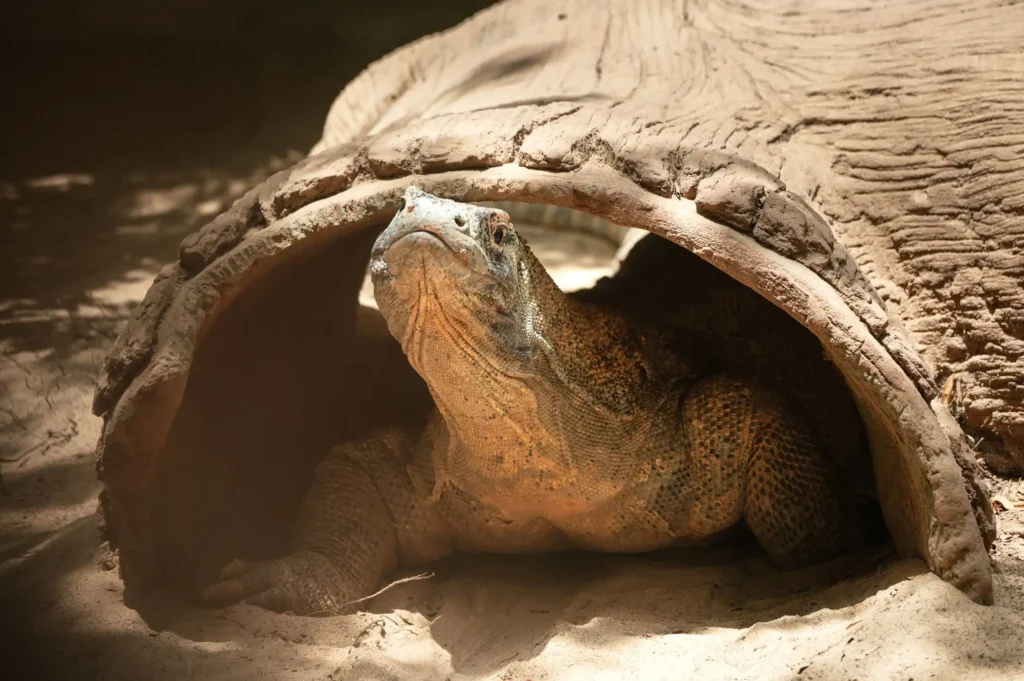The first description of a Komodo Dragon was in 1912 and described them as “unusually large Veranus”. The first record of this species was made from a photograph and a skin sample.
The Komodo Dragon or Veranus Komodoensis was classified as rare in 1986 and is currently classified as vulnerable by the IUCN (The International Union for Conservation of Nature).
Of this saurian, no doubt a wonder of the natural world, there are around 6.000 examples left, living on various Indonesian islands: Komodo (1.700), Rinca (1.300), Gili Motang (100) y Flores (approximately 2.000 in coastal areas)
Characteristics:
This saurian is the largest in the world, being able to grow up to 3’5 meters and weigh from 80 to 140kg, the males being slightly bigger than the females. Their tails are as long as their bodies and they have long, yellow, bifid tongues.
They are related to mosasaurs, marine reptiles that lived over 136 million years ago and grew up to 17m long. Although there is a large genetic diversity across the natural range of the species, subspecies have not yet been recognized.
Komodo dragons hunt during twilight, until night fall. During the day, when the sun is at its hottest, the lizard is inactive, sunbathing to re-energize itself, being an ectothermic animal, meaning the regulation of its body temperature depends on external sources, like the sun. It’s a territorial animal that lives in solitary, except during the mating season.
These reptiles are considered to be the most intelligent lizards, as they can develop new hunting skills by learning from experience.
When hunting they hide, to give themselves the surprise advantage against their prey, although if needed they can run at around 20km/h in short distances. Normally they hunt in groups for larger prey, using their sense of smell to help them.
They live in burrows that are found up to 3 meters under the surface. They are able to dig these burrows thanks to their powerful limbs and tend to make them in riverbeds, hills, places they can hide and stalk their prey from.
And remember, looks can be deceiving. This animal can swim and climb trees!
It has a lifespan of up to 30 years, reaching sexual maturity at approximately five years old. The females lay from 20 to 40 eggs with an incubation period of 8 months.
They can see up to a distance of 300 meters away, but has very poor eyesight at night as its retinas only have cones (responsible for colour and bright light vision).
In regards to their hearing, it’s quite weak seeing as they only have a bone to transfer sounds between 400 and 2000 Hertz, whilst humans can hear between 20 and 20,000 Hertz. This means that they are unlikely to hear high pitched sounds. But on the other hand, their sense of smell is incredible, being able to smell carrion over 4 miles away.
They use their tongues to detect flavours and stimulate their sense of smell, like many other reptiles.
Colour:
Newly hatched dragons are coffee coloured, with yellow and orange marks on their backs, which make it able to distinguish one from another. They also have grey front legs and white and yellow patches on their darker stomach area.
Young adult komodo dragons have a lighter colouring on their heads although they lose their bright colours they had when younger.
The fully grown adults are a more uniform brown with the females having a slightly green-ish head.
Alimentation:
They are carnivorous and have a extremely varied diet including insects, eggs, birds, deer, buffalos, horses, farm animals like pigs, goats, carrion and they even eat other komodo dragons. It can also be dangerous to men, as it hunts large animals it can also consider humans to be prey.
Its teeth can be compared to those of a shark, with a total of 60 teeth that can be up to 2’5cm long and is renewed by another as soon as one falls out. Their jaws are not made to chew, so they swallow large pieces of meat at a time, even swallowing skin, feathers, horns and hooves. They can eat up to 80% of their weight, and then they go to a sunny place to accelerate digestion. After digesting the food, it regurgitates the parts its body cannot digest like hair, teeth, feathers, in the form of pellets. (Just like birds do, swallowing prey whole then regurgitating the parts made up of lots of keratin)
As they live in dry areas, nearly all of the liquid in their diet is provided by their food. If larger prey is hard to find, they can survive feeding just once a month, meanwhile eating smaller prey.
Their territory can be up to 2km², although they don’t actively defend them, so they may overlap. When feeding there is a strict order, the dominant male will have first choice, then the rest, in order of hierarchy, the youngest being the last to eat.
Toxic Saliva:
Once these reptiles have bitten their prey it’s very rare for them to survive, even if they escape after the attack. The komodo dragon will harass its sick prey until it dies, around two days later.
This is because although it’s not a strictly a venomous bite, it’s a dangerous one, not just because of the physical damage but the very infectious bacteria that lives in the saliva. There are over 50 types of bacteria in the komodos saliva, four of them with no known antidote.
In the case of bites on human beings, if they are treated promptly with broad-spectrum antibiotics they will heal with no problems, however in the wild these bites can be deadly.
There are ongoing studies about the saliva’s toxicity and the reason it doesn’t affect other komodo dragons, as it’s been seen that if one bites another they do not die from infection as other animals do.
Parthenogenesis:
Experts have been published in the British scientific journal, Nature, after finding out that these astonishing creatures are capable of reproducing by parthenogenesis, an asexual way of reproduction. These studies were featured on the example of two females living in captivity, never coming into contact with a male, yet laying viable eggs.
A female found in Chester Zoo (UK), laid 25 eggs in May 2006, of which eleven appeared to be viable, and without ever before coming across a male of the specie, five offspring were born.
In another case, a female in London Zoo laid eggs two and a half years after its last encounter with a male and once again offspring were born.
Scientists at the University of Liverpool tested the paternity of these offspring, the result being that the genotype of the litter was the exact same as its parent, meaning that the females were both mother and father of the eggs.
In a short explanation, this happens because they are not like mammals XY but ZW, allowing them to perform fertilization on the eggs and double the chromosomes so later they are diploid. (In mammals the chromosomes are half mother, half father and join to form the fetus). If the eggs receive the Z chromosomes they’ll be ZZ and be males, if they receive the W chromosomes they’d be WW but won’t be born, as females are ZW.
It has been hypothesized that this adaptive reproduction system could mean that a single female could have populated whole islands by hatching males through the asexual reproduction then mating with her offspring to create more males and females.
According to Kevin Bulay, co-author of the article in Nature, parthenogenesis had already been discovered in other species of lizards, but these are the first known cases in the komodo dragons.
Habitat and Geographical Areas: They inhabit forests, plains, savannas and dry rocky areas. Native of several Indonesian islands such as Komodo, Rinca, Flores and Gili Motang.
Threats: Volcanic activity, earthquakes, loss of habitat, fires, loss of prey, tourism and poaching, including dynamite fishing in coastal reefs, have contributed to this species current vulnerability.
Poaching is now punishable by 10 years in prison.
Conservation Measures:
It has been included in Appendix I of CITES.
They have made great efforts to protect this specie. Komodo dragons are protected by the National Park Komodo, founded in 1980 and includes the islands of Komodo, Rinca and Padar. Later opening the Biosphere Reserve of Flores; providing a total of 60.000 hectares of protection.
In addition, some of these reptiles carry electronic chips for monitoring and study for a better understanding of the species.
Researchers from Australia, San Diego, USA, and organizations such as Komodo Foundation are working to ensure the conservation of this specie.
Common name:
English: Komodo Dragon: Komodo Monitor, Ora
French: Des Komodo Dragon, Komodo Varan.+





